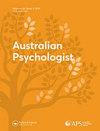Factorial and construct validity of the Cognitive Emotion Regulation Questionnaire (CERQ) in an Australian sample
IF 2
4区 心理学
Q2 PSYCHOLOGY, MULTIDISCIPLINARY
引用次数: 0
Abstract
ABSTRACT Objective The Cognitive Emotion Regulation Questionnaire (CERQ) is a 36-item self-report measure of nine emotion regulation strategies, extensively used in research. Despite widespread use, the instrument’s factor structure has not been investigated in an Australian sample, and some international scholars have questioned the factorial validity of the English translation. This study examined the CERQ’s psychometric properties in an Australian community sample. Method A sample of 781 Australian adults completed an online questionnaire consisting of demographic information, the CERQ, and the Depression Anxiety Stress Scale (DASS-21). Results Confirmatory factor analysis revealed that the original nine-factor model was not a good fit for the sample data, and a seven-factor model emerged as the best solution. The study investigated the construct validity of the seven-factor model by examining the relationship to self-reported psychological distress (DASS-21). Correlational and regression analysis supported construct validity; however, correlational results for the acceptance subscale suggest conceptual ambiguity. Conclusion The results demonstrate that a more parsimonious seven-factor model, rather than the proposed nine- and five-factor solutions, was the best fit for our data and suggest the factor structure of the CERQ may vary significantly between samples. Key Points What is already known about this topic: The Cognitive Emotion Regulation Questionnaire (CERQ) is a popular measure of emotion regulation that is used in both research and practice. The CERQ has been validated in other language translations, but there are few studies that examine the psychometric properties of the English translation. The subscales of the CERQ have been grouped into maladaptive and adaptive strategies. What this topic adds: Despite widespread use, this study represents the first known attempt to validate the factor structure of the CERQ in an Australian sample. This study examined multiple possible factor structures of the English translation of the CERQ based on previous research, and a novel seven-factor solution emerged as the best fit for the data. Maladaptive coping strategies were associated with higher levels of psychological distress, although only one of the adaptive strategies was related to lower levels of psychological distress.认知情绪调节问卷(CERQ)在澳大利亚样本中的析因和结构效度
摘要目的认知情绪调节问卷(CERQ)是一种包含9种情绪调节策略的36项自述量表,在研究中被广泛使用。尽管广泛使用,但该工具的因子结构尚未在澳大利亚样本中进行调查,一些国际学者质疑英语翻译的因子效度。这项研究在澳大利亚社区样本中检验了CERQ的心理测量特性。方法对781名澳大利亚成年人进行在线问卷调查,包括人口统计信息、CERQ和抑郁焦虑压力量表(DASS-21)。结果验证性因子分析表明,原来的九因子模型不能很好地拟合样本数据,七因子模型是最佳的解决方案。本研究通过检验学生自我报告心理困扰(DASS-21)的关系来检验七因素模型的结构效度。相关分析和回归分析支持构念效度;然而,接受分量表的相关结果显示概念模糊。结论研究结果表明,一个更简洁的七因子模型比九因子和五因子模型更适合我们的数据,并且表明CERQ的因子结构在样本之间可能存在显著差异。认知情绪调节问卷(CERQ)是一种流行的情绪调节测量方法,在研究和实践中都有使用。CERQ已经在其他语言翻译中得到了验证,但很少有研究检验英语翻译的心理测量特性。CERQ的子量表分为自适应策略和不适应策略。本课题补充的内容:尽管广泛使用,但本研究代表了首次在澳大利亚样本中验证CERQ因子结构的已知尝试。本研究在前人研究的基础上考察了CERQ英译的多种可能的因素结构,并提出了一种最适合数据的新颖的七因素解决方案。尽管只有一种适应策略与较低水平的心理困扰相关,但适应不良的应对策略与较高水平的心理困扰相关。
本文章由计算机程序翻译,如有差异,请以英文原文为准。
求助全文
约1分钟内获得全文
求助全文
来源期刊

Australian Psychologist
PSYCHOLOGY, MULTIDISCIPLINARY-
CiteScore
3.70
自引率
5.30%
发文量
32
期刊介绍:
The Australian Psychologist is the official applied practice and public policy journal of the Australian Psychological Society. As such, the journal solicits articles covering current issues in psychology, the science and practice of psychology, and psychology"s contribution to public policy, with particular emphasis on the Australian context. Periodically, Australian Psychological Society documents, including but not limited to, position papers, reports of the Society, ethics information, surveys of the membership, announcements, and selected award addresses may appear in the journal.
 求助内容:
求助内容: 应助结果提醒方式:
应助结果提醒方式:


